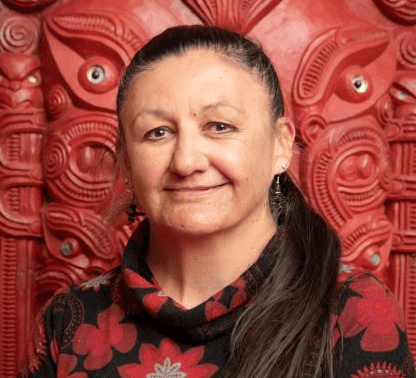Sara has a deep appreciation for science. From her 18 years with the Greater Wellington Regional Council, to her involvement with the BioHeritage National Science Challenge, to her recently tenured position at Te Herenga Waka – Victoria University of Wellington (VUW), her mahi spans biosecurity, ecology and conservation. She sees science as a subset of mātauranga Māori and is dedicated to providing insight into science practices by viewing it through a Māori lens.
“The cosmology and epistemology of mātauranga in science has become where I sit,” says Sara.
Her first opportunity to really explore the intersection of mātauranga and science was through her PhD at VUW, partially funded by BioHeritage. She created a framework that linked mātauranga perspectives and cultural indicators (such as mauri, wairua and whakapapa) to Western science metrics.
“When Māori indicators are included, they are often put alongside Western science indicators,” she says. “But they seldom cross-pollinate one another.”
Sara wanted to change that. To do so, she created the Environmental State Assessment Tool (ESAT), which allowed Māori perspectives to be overlaid on top of quantitative Western science data. The tool is designed to accommodate different cultural values and perspectives as well as different definitions of the same value.
“Mauri and whakapapa mean different things to different iwi. With ESAT, you can adjust the metric to match your criteria for what you believe whakapapa to be. This enables land managers to look at the differences in the outcomes for the health of the environment based on what their objectives are, what lens they are applying and what their management goals are.”
Sara brought the completed ESAT to BioHeritage as a research assistant. Specifically, she used the tool to assess the cultural and environmental impacts of genetically modified wasps in Aotearoa.

“For Māori, genetic modification affects the wairua, the mauri or the whakapapa because it takes a bit of DNA from one species and puts it into another.”
However, the nature of gene modification technology has changed over time, which has led to changes in Māori perspectives. Sara worked with the Novel Tools & Strategies – Invertebrates team and the community to identify roadblocks and dealbreakers for the possibility of constructing a gene drive to make pest wasps infertile.
“There are still a lot of issues with genetic modification from a Māori perspective, but it may not be as frowned upon as it used to be. It’s actually more preferable than using toxins in some cases. And doing nothing is not an option.”
Her work with wasps led to a postdoc applying ESAT to the economic and cultural outcomes of genetic modification of rats as part of the Predator Free 2050 effort. After working for three months on this project, she was offered tenure at VUW. While this change does distance her from the research, it has also led to new opportunities.
“Now that I’ve got tenure, I’ll be applying for research funding to take ESAT from prototype stage to an open-source web portal,” says Sara. “I want it to be available for resource managers, iwi, and anybody else to use.”
BioHeritage offers their congratulations to Sara for her tenured position and looks forward to a future where ESAT is available for all.
– Jenny Leonard
